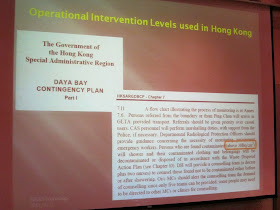The first speaker was Dr. Ni (倪鵬飛) and he analyzed the competitiveness among different cities in China especially Hong Kong.

The analysis framework was introduced. He emphasized that Innovation and Technology was core competitiveness of city.
Hong Kong is still number one in General Competitiveness. (The first six ranking is Hong Kong, Shanghai, Bejing, Shenzhen, Taipei and Guangzhou.) However, Hong Kong was behind in science technology competitiveness and only ranked 26.
Then Dr. Ni identified three opportunities and challenges. They were:
- Good Asia and China economic development trend
- After economic crisis, innovation and technology would be more and more important. The technology revolution would be come.
Hong Kong ten advantages on Innovation and Technology were described included international level universities, finance system, legal system, information technology, location advantage, good economic foundation, integrity government, freedom economic area, good management of enterprise, and academic freedom.
However, Dr. Ni pointed out the deficient of Innovation and Technology development in Hong Kong.
- No momentum for developing innovation and technology in enterprise such as risk management, motivation measures and culture & environment.
- No condition for developing innovation and technology in enterprise such as integrated strategy mechanism, service platform, education and talent insufficient.
After that, Dr. Ni suggested the positioning and strategy for Hong Kong's innovation and technology development. Hong Kong should become Global City and positioning Hong Kong to be "Global Innovation and Technology Centre", "Asia IP Trading and Servicing Centre", "Oversea Innovation and Creative Design Centre for Mainland China", etc.
Some strategies were suggested to enforce the development of innovation and technology in Hong Kong such as implementation of CEPA supplementary document 7, etc. At the end, Dr. Ni concluded it should be enhanced the responsibility of Hong Kong Government and he supported to establish "Innovation and Technology Bureau".
The group discussion was performed. (Left: Dr. Samson Tam Wai Ho (譚偉豪), Mrs. Fanny Law (羅范椒芬), Mr. LAU Kong Wah (劉江華), Ms. Emily Lau Wai-hing (劉慧卿), Prof. Chan Chi-fai, Andrew (陳志輝) and Dr. Ni (倪鵬飛))
Mrs. Fanny Law presented different ranking system for Hong Kong.
She compared three ranking systems and summarized that Hong Kong were weak in science, technology and innovation among the evaluation.
Finally, Mrs. Law concluded four points should be implemented in Hong Kong. They were Innovation and Technology Strategy Enhancement, Investment on Higher Education, Open HR market and matching National Development Strategy.
During the discussion, Mr. LAU Kong Wah suggested to form Professional Service Centre to assist Hong Kong's professionals to develop their business in China. Moreover, he mentioned the change of concept about relationship between Government and Market.
Ms. Emily Lau Wai-hing described the advantage of Hong Kong is Freedom, Legal and System. She pointed out the investment on research and technology was less than 2% of Hong Kong GDP.
Dr. Samson Tam suggested to enhance Internet Economic and to develop other kind of industry which China was not able to do. Moreover, he suggested not only Hong Kong people used Hong Kong product, but also Guangdong people also use Hong Kong product, so as to enlarge the market and good for innovation and technology development in Hong Kong.
At the end, all guests supported to establish Innovation and Technology Bureau in Hong Kong.
After the seminar, my Australia friend introduced the restaurant for Pakistani, Indian adn Arabic food called "Ziafat restaurant" in TST.
Then we saw a drama called "Boundless Movement" (遍地芳菲) to commemorate Centenary of China's 1911 Revolution (纪念辛亥革命100周年).
Reference:
Beijing-Hong Kong Academic Exchange Centre - http://www.bhkaec.org.hk/
TechMatrix Research Centre - http://www.techmatrix.hk/en/
Hong Kong Professionals and Senior Executives Association - http://www.hkpasea.org/
Ziafat restaurant: 6/F, Harilela Mansion, 81 Nathan Road, TST, Kowloon, HK.
Boundless Movement (遍地芳菲) - http://www.hkrep.com/tc_chi/season/2011-season2-1.html






















































